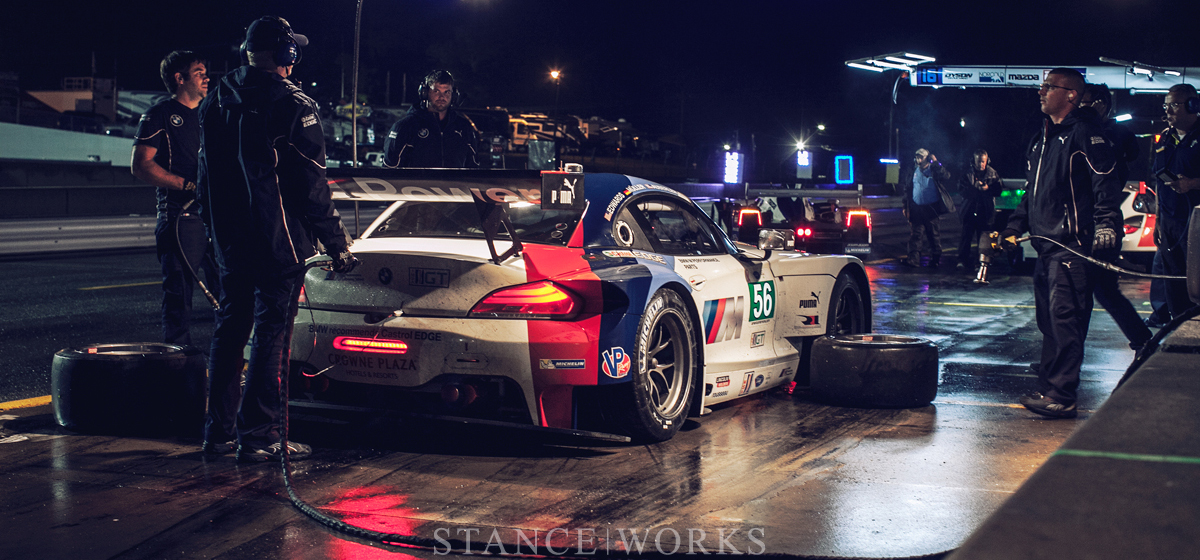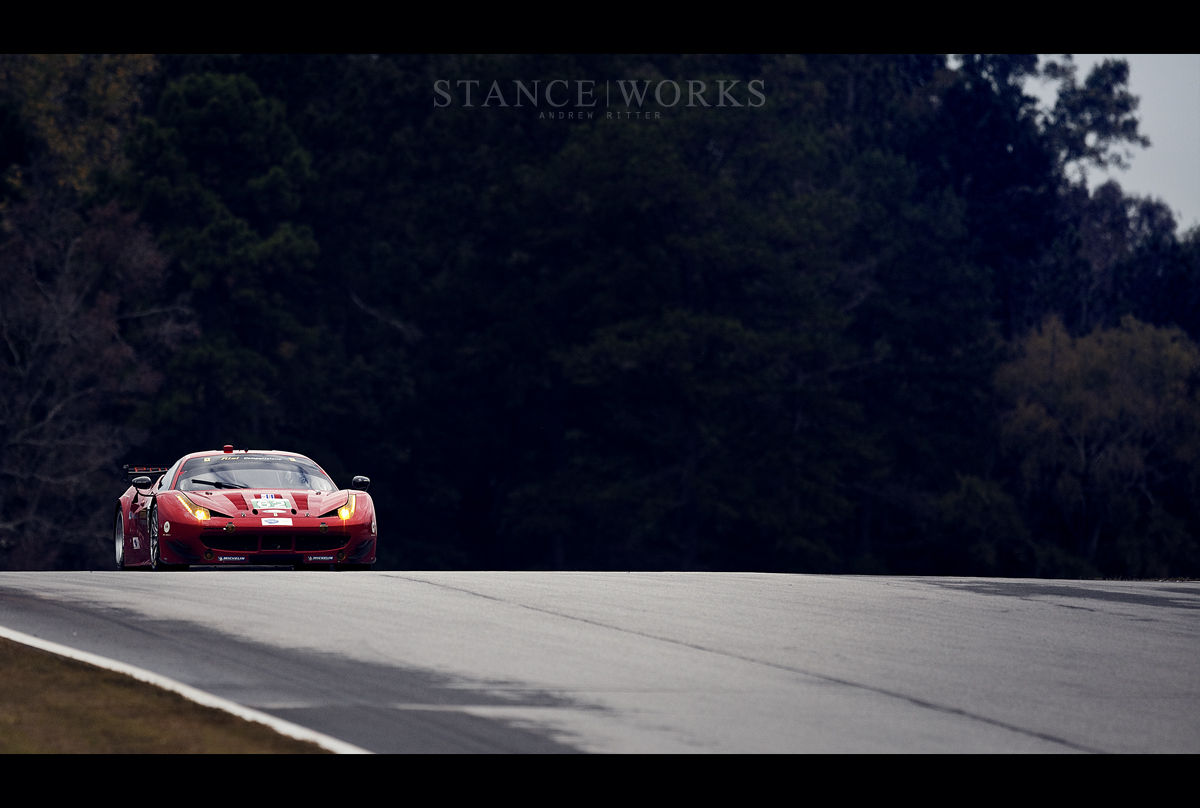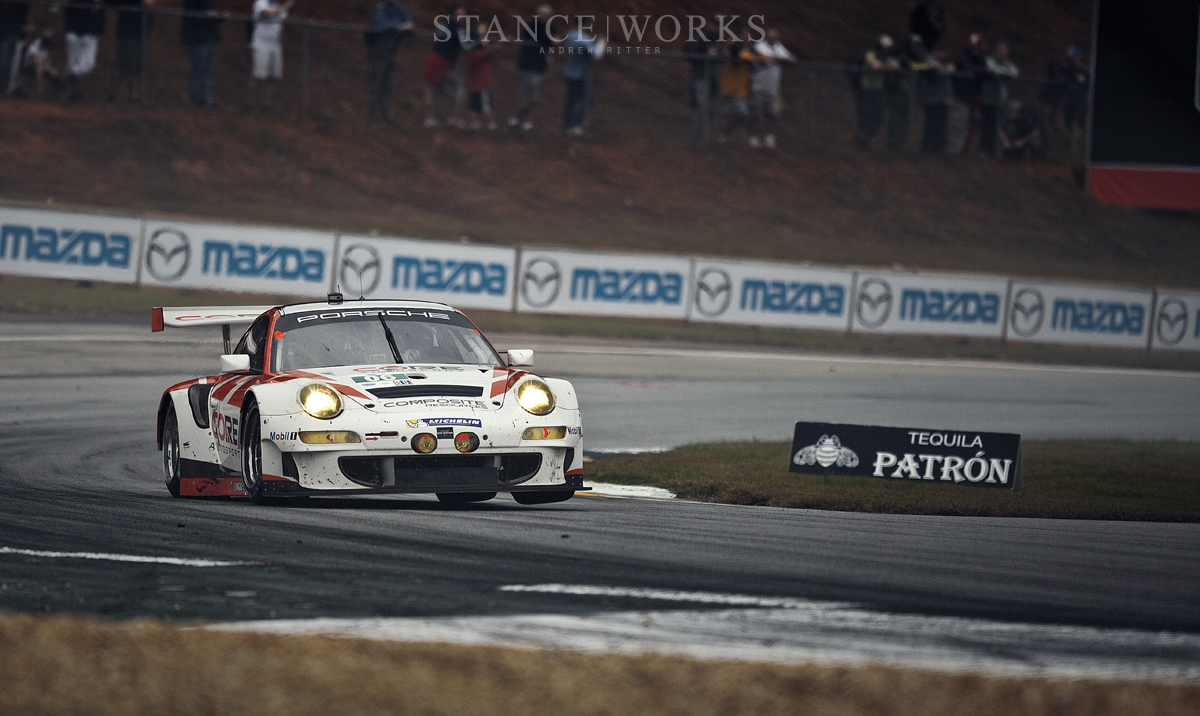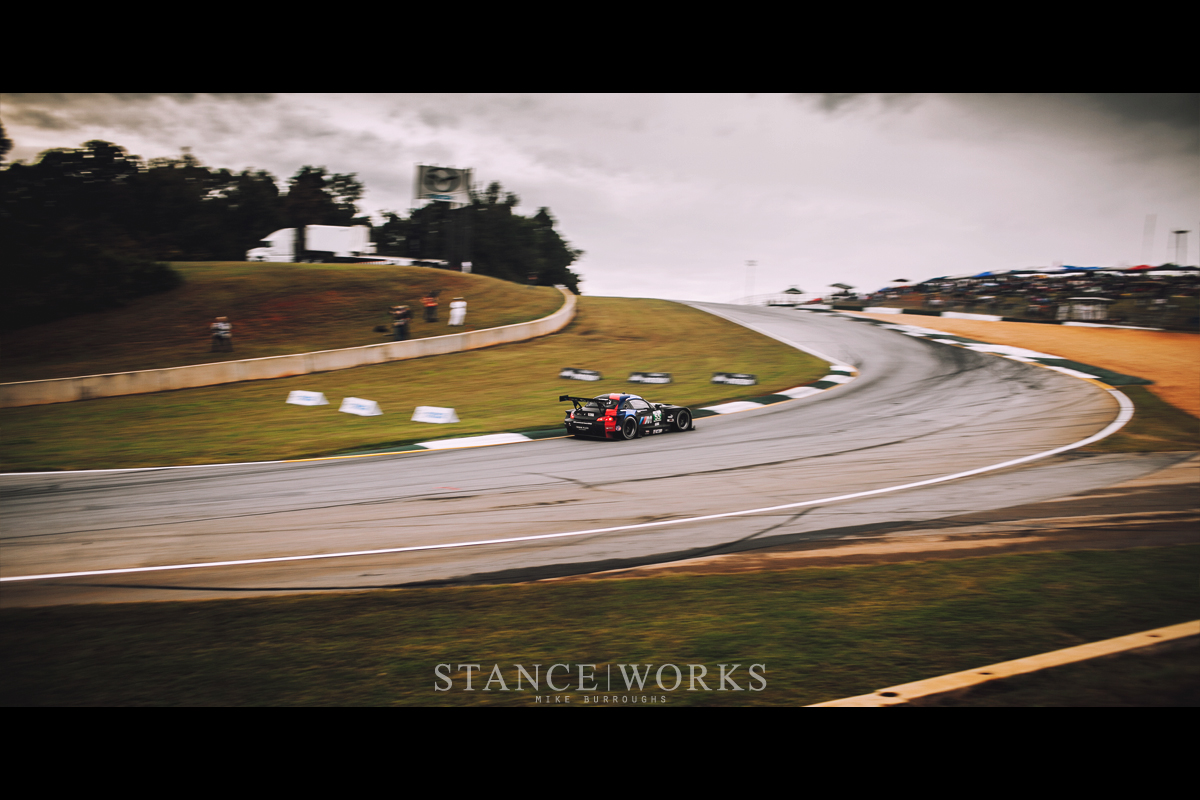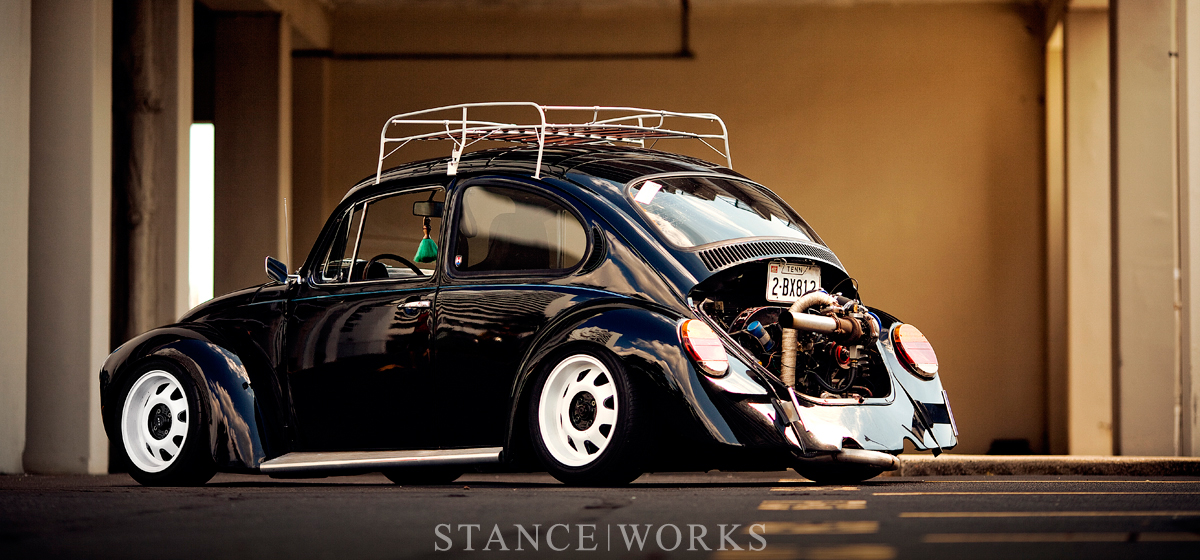As our plane touched down on the tarmac, it quickly became apparent that Atlanta’s weather was a far cry from the sun that we had left behind in Southern California. The dark skies cast a shadow over our arrival while Mike and I wondered what Mother Nature had in store for us. Our itineraries indicated a 30% chance of rain that we paid little attention to when we packed for the weekend. Embarking on the drive to Road Atlanta, we began to regret that our rain jackets remained hanging in our closets back home. A light drizzle turned into a heavy rain, and the sky grew darker. It let up enough at times to allow a little hope for a dry track to peek through, but the rain quickly returned to soak our optimism. The rain held strong as we pulled into the paddock, but it wouldn’t be enough to overshadow our excitement for the weekend ahead. Mike and I readied our gear, eager to begin our first Petit Le Mans.
The Petit Le Mans race holds a special place in American sports car racing. Dating back to 1959, the World Sportscar Championship offered an international series for endurance and road racing. The WSC can be credited for many of the historic races that we still cherish today. From the classic cars that competed in Targa Florio to the Group C cars that raced day and night through the Le Mans circuit, it offered a worldwide race series that enraptured fans. Unfortunately, as WSC engines evolved and costs rose, many manufactures began to drop out of sports car racing, and some set their sights on Formula 1. With too few teams to justify the 1993 season, the WSC discontinued its series, leaving the world without a united race league.
In its absence, The Automobile Club de l’Ouest, the organization behind the legendary Le Mans 24 Hour Race, sought to develop a new worldwide series for sports car competition. The ACO reached out to Don Panoz, the owner of Road Atlanta, with a proposal. Offering him the use of the iconic ‘Le Mans’ title, the ACO hoped to test the waters for a future series in the United States. Don Panoz agreed, and in 1998, held the first Petit Le Mans at Road Atlanta.
Structured around many of the same rules, Petit Le Mans (‘Little Le Mans’) paid tribute to the Le Mans 24 Hour Race, and brought another european style endurance race to America to stand with the 12 Hours of Sebring. Racers would compete on the hills of Road Atlanta for 10 Hours or 1000 Miles, whichever came first, for an invitation to France to compete in the 24 Hours of Le Mans. This monumental opportunity attracted 31 entrants with giants like the Porsche Gt1 and Ferrari 333 SP in attendance. Seeing the great success, ACO and Don Panoz worked together to bring us the American Le Mans series with its premier season in 1999.
We found ourselves standing trackside at Road Atlanta as the paddocks bustled with life for the 16th Petit Le Mans. It’s been a staple venue since the start and it’s one that the teams always look forward to. As the main catalyst for ALMS, it seemed appropriate that Petit Le Mans would serve as the final race of the series. Mike and I walked through the paddocks, taking it all in once again. Team RLL was busy at work, preparing the Z4s for their last practice before qualifying.
With the rain still collecting on the asphalt, teams were hesitant to send their cars out onto the dark track, but rules dictate that each driver must complete 3 laps during the night practice to qualify for the race. The BMWs made their way down pit lane where they received their final preparations before setting off. In fear of last minute catastrophes before race day, Team RLL opted to send out their drivers for only a few laps, getting a feel for their rain tires and meeting the lap requirements. The telemetry screens lit the pit and the team looked on as the cars made their way through the storm. Drivers exchanged positions, swapping for their chance in the driver’s seat. The #55 and #56 cars looked great as they crested the hills, unhindered by the conditions.
It wasn’t until the end of their run that everyone in the pit stopped to watch as the #55 car went off the line in turns 10 and 11, missing turn 12 and sliding off course into the tire wall. The crew fell silent as they waited to see what damage had been done. Fortunately, the gravel did its job and drained the car of momentum before it came to a soft stop in the tire wall. That was it for the night. Towed back to the paddocks, the Frost Black Z4 was under the knife immediately. The team cleared out the water, removed the debris, and disassembled the car with well practiced precision. It was back together again before the night came to a close, and it’d be ready to go back out and fight for a position on the grid the next day.
With their last win, Corvette had already won the Team Championship in the GT Class, but Dirk Müller was still in the running for the Driver’s Championship, and the other podium spots remained open in the Team competition. Piloting the #56 car with his teammates, Bill Auberlen and John Edwards, Dirk needed to stand atop the podium to clinch the title. Having already stood on the #1 step this season, it was well within reach. Maxime Martin, Jörg Müller and Uwe Alzen manned the other Z4 and would be fighting to ensure that BMW stood, once again, on the podium for the Manufacturer’s Championship and Team Championship. Hopes were set high, equally matched by our excitement as the race grew nearer.
The green flag waved under rainy skies, the grid kicked up rooster tails, and the last ALMS Petit Le Mans was underway. The yellow lights of the GT class bounced off the glistening pavement as the pack charged down The Esses, searching for the driest line. For the initial hours of the race, the rain was intermittent. Rain showers gave way to moments of calm that allowed the track enough time to dry before the next drizzle began. With such uncertain conditions, pit strategy becomes paramount; tire changes can easily be the deciding factor between sliding into the wall or running to the front of the class. As cars struggled to find traction, the race went under 4 caution periods within the early hours of competition. Contact between cars forced pit stops for mechanical repairs and the lead went back and forth between teams.
Just a few hours into the 10 hour race, Mike and I had to pack up and hit the road once again. Relying on our iPhones for live race updates, we watched as the GT teams continued to fight for the Team Championship. The Risi Competizione Ferrari had situated itself in front of the Corvettes and BMWs, marking a competitive season for the red Italian supercar. In the heated battle for the lead, The Ferrari came in contact with the #3 Corvette, damaging the Risi Competizione car and allowing the #56 BMW Z4 to sneak ahead. We eagerly watched as the live scores updated time and time again with the BMW Z4 in the lead. It seemed as if Dirk would get the Driver’s trophy that he had been fighting so hard for.
More cars dropped off under the wear and tear of endurance racing. Electrical problems rendered the #4 Corvette inoperable while one of the SRT Vipers ended its race with a collision into the tire wall. Endurance racing can be one of resiliency, especially in such conditions. The Falken team stayed strong and showed that they could weather the storm. The newly liveried Porsche GT3 RSR made it’s way through the class from it’s 6th position in grid, avoiding the contact damage and mechanical issues that plagued some of the other teams over the course of the race. Their determined focus paid off as they crossed under the checkered flag, followed closely by the #56 BMW Z4. Risi had fixed the car and made the climb back to finish in third place, a podium spot that was surely well deserved by the pit crew. The Corvette was able to complete the 1000 mile race in 5th place, allowing Magnusson and Garcia to win the Driver’s Championship.
Dirk Müller’s second place was not enough to land him in first for the Driver’s Championship; however, their strong efforts at Road Atlanta were enough to put BMW in second place for the Team and Manufacturer’s Championships. Both teams fought hard the entire season and put it all on the line at Road Atlanta to cap off a very successful first season for the BMW Z4s. Originally written off as a developmental season for the new GTE cars, it’s apparent that they already have a competitive car on their hands. Both cars finished races in first this season and were able to secure additional podium finishes. Finishing second in the Team competition, Team RLL was able to record a stronger first season than even their M3 predecessors. The Z4s will continue into the next season as ALMS merges with Grand Am.
For Mike and I, an endurance race of our own continued as we lugged our equipment onto another plane, sharing trackside stories about our time at Road Atlanta. We had watched our friends at BMW and Team RLL finish another strong season in ALMS, and we look forward to returning to Road Atlanta next October as BMW battles it out in the Tudor United Sports Car Championship, the newly formed union between ALMS and Grand Am. For now, we were on our way to the next track with memory cards to fill and an excitement that only heightened as we got closer to our destination. To be continued in Part 2…

